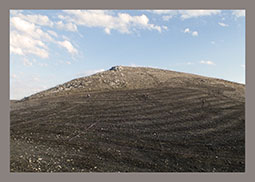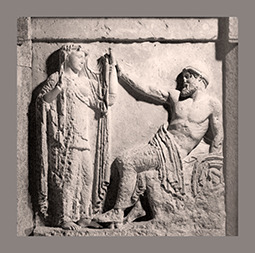Autore: G. Spagnolo
Scarica l’articolo in formato .pdf: Una testina fittile di Io dal santuario della Madonna dell’Alemanna a Gela
 Oggetto del contributo è una singolare testina fittile femminile con corna ed orecchie bovine, rinvenuta nel 1951 sulla collinetta della Madonna dell’Alemanna, a Nord della città di Gela. Qui, a seguito della scoperta casuale di una fossa votiva di VII-VI sec. a.C., gli studiosi localizzarono un importante santuario extraurbano della polis greca e lo attribuirono a Demetra soprattutto in virtù della suddetta testina, recuperata al di fuori della fossa, perché ritennero che essa fosse allusiva al legame tra la dea, i bovini e l’agricoltura. In assenza di dati specifici sulla giacitura originaria del pezzo, il presente studio ne fissa la datazione intorno alla metà del V sec. a.C. su base tipologica e stilistica e lo assegna a fabbrica locale. Attraverso poi la disamina di numerose fonti letterarie e iconografiche, la ricerca perviene all’ipotesi che il frammento possa essere pertinente ad una statuetta di aspetto ibrido, insieme umano e animale, che rappresentava Io, la famosa sacerdotessa del santuario di Hera ad Argo, amata da Zeus, trasformata in candida vacca e poi assurta al rango di eroina capostipite della regale stirpe degli Achei. Alla luce di tale identificazione, lo studio affronta il complesso problema del rapporto tra la figura di Io e quella di Hera, divinità di riferimento della sacerdotessa nella sfera del mito, specificamente nell’ambito argivo; ed inoltre, prendendo in esame altri esempi di manufatti di varie provenienze raffiguranti l’eroina, indaga sulla possibilità di eventuali riflessi di tale rapporto nelle attività rituali connesse con il culto della dea. In conclusione, viene dunque avanzata l’ipotesi che sulla collinetta dell’Alemanna esistesse un edificio o uno spazio dedicato a Hera Argiva.
Oggetto del contributo è una singolare testina fittile femminile con corna ed orecchie bovine, rinvenuta nel 1951 sulla collinetta della Madonna dell’Alemanna, a Nord della città di Gela. Qui, a seguito della scoperta casuale di una fossa votiva di VII-VI sec. a.C., gli studiosi localizzarono un importante santuario extraurbano della polis greca e lo attribuirono a Demetra soprattutto in virtù della suddetta testina, recuperata al di fuori della fossa, perché ritennero che essa fosse allusiva al legame tra la dea, i bovini e l’agricoltura. In assenza di dati specifici sulla giacitura originaria del pezzo, il presente studio ne fissa la datazione intorno alla metà del V sec. a.C. su base tipologica e stilistica e lo assegna a fabbrica locale. Attraverso poi la disamina di numerose fonti letterarie e iconografiche, la ricerca perviene all’ipotesi che il frammento possa essere pertinente ad una statuetta di aspetto ibrido, insieme umano e animale, che rappresentava Io, la famosa sacerdotessa del santuario di Hera ad Argo, amata da Zeus, trasformata in candida vacca e poi assurta al rango di eroina capostipite della regale stirpe degli Achei. Alla luce di tale identificazione, lo studio affronta il complesso problema del rapporto tra la figura di Io e quella di Hera, divinità di riferimento della sacerdotessa nella sfera del mito, specificamente nell’ambito argivo; ed inoltre, prendendo in esame altri esempi di manufatti di varie provenienze raffiguranti l’eroina, indaga sulla possibilità di eventuali riflessi di tale rapporto nelle attività rituali connesse con il culto della dea. In conclusione, viene dunque avanzata l’ipotesi che sulla collinetta dell’Alemanna esistesse un edificio o uno spazio dedicato a Hera Argiva.
The topic of this paper is a singular female clay head with bovine horns and ears, found in 1951 on the hill of “Madonna dell’Alemanna”, northwards the city of Gela. After the accidental discovery of a votive pit dating back to the 7th-6th cent. BC, scholars located here an important extra-urban sanctuary of the Greek polis and attributed it to Demeter on the basis of the female clay head, found outside the pit, because they considered it allusive to the relationship between the goddess, cattle and agriculture. Without specific data on the stratigraphic context of the artefact, the present study fixes its dating around the middle of the 5th cent. B.C. on a typological and stylistic basis and attributes it to a local workshop. Then, through the examination of numerous literary and iconographic sources, the investigation comes to the hypothesis that the artefact may be pertinent to a hybrid figurine, both human and animal, which represented Io, the famous priestess of the sanctuary of Hera in Argos, loved by Zeus, transformed into a white cow and then arisen to the rank of heroine progenitor of the royal lineage of the Achaeans. Beginning with this identification, the research deals with the problem of the relationship between the character of Io and Hera, the reference deity of the priestess in the sphere of myth, specifically in the Argive context. Furthermore, considering other items from various provenances depicting the heroine, the study investigates the possibility of any influences of this relationship in the ritual activities connected with the worship of the goddess. As a final point, the search formulates the hypothesis that on the Alemanna hill there was a building or a space dedicated to Hera Argiva.








